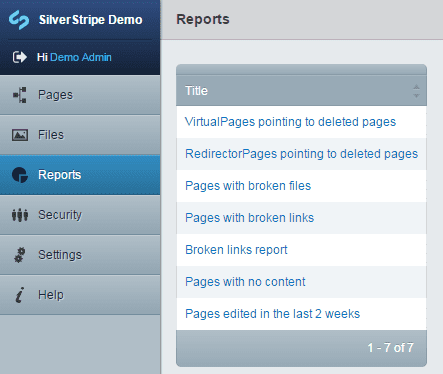Customise site reports
Introduction
Reports are a useful feature in the CMS designed to provide a view of your data or content. You can access the site reports by clicking Reports in the left hand side bar and selecting the report you wish to view.
Default reports
By default the CMS ships with several basic reports:
- VirtualPages pointing to deleted pages
- RedirectorPages pointing to deleted pages
- Pages with broken files
- Pages with broken links
- Broken links report
- Pages with no content
- Pages edited in the last 2 weeks
Modules may come with their own additional reports.
Creating custom reports
Custom reports can be created quickly and easily. A general knowledge of SilverStripe's datamodel and ORM is useful before creating a custom report.
Inside the mysite/code folder create a file called CustomSideReport.php. Inside this file we can add our site reports.
The following example will create a report to list every page on the current site.
###CustomSideReport.php
class CustomSideReport_NameOfReport extends SS_Report {
// the name of the report
public function title() {
return 'All Pages';
}
// what we want the report to return
public function sourceRecords($params = null) {
return Page::get()->sort('Title');
}
// which fields on that object we want to show
public function columns() {
$fields = array(
'Title' => 'Title'
);
return $fields;
}
}
More useful reports can be created by changing the DataList returned in the sourceRecords function.
Notes
CustomSideReport_ReportNamemust extendSS_Report- It is recommended to place all custom reports in the 1 file.
- Create a CustomSideReport.php file and add classes as you need them inside for each report
TODO
- How to format and make advanced reports.
- More examples
